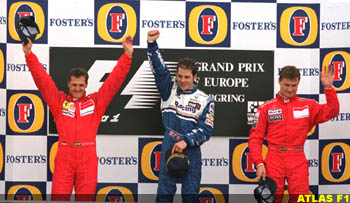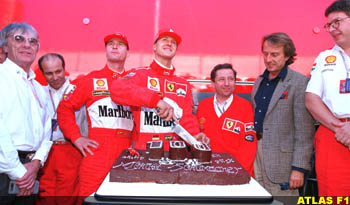|
The Luxembourg Grand Prix brings an interesting twist to the Formula One nostalgia lovers - a history of the race, which is only in name connected to the small country between Belgium and Germany, would provide for a very short article. Only last season a Grand Prix was first named the Luxembourg Grand Prix. The Grand Duchy itself never hosted a Formula One event, only a few sportscar races in the first half of this century and a range of Formula Three races on a track near the airport. Nevertheless, Luxembourg joins a long listed history of double Grands Prix in one country - though with two different titles - in the same year.
This idea is not as new as it may seem. Back in 1957 Italy already hosted two races: the Italian Grand Prix and the Pescara Grand Prix, both won by Stirling Moss in the overpowering Vanwall. The race at Pescara wasn't planned ahead like the Luxembourg Grand Prix in this age. The race was merely inserted because the season was getting awfully short with races in Belgium and Holland being canceled.
 Besides various cases of up to three races a year in the United States, the idea of multiple races in one country first got started back in 1983, when the first European Grand Prix was held at Brands Hatch. From 1963 on, Silverstone and Brands Hatch platooned for the British Grand Prix, with Silverstone being used in odd years and Brands Hatch in even years. The addition of a European Grand Prix gave Brands Hatch the opportunity to host a race every year, with the event being called either European or British Grand Prix. However, it did not last for long: after the 1986 British Grand Prix, Brands Hatch did not host a Formula One event anymore and the European Grand Prix was canceled. Besides various cases of up to three races a year in the United States, the idea of multiple races in one country first got started back in 1983, when the first European Grand Prix was held at Brands Hatch. From 1963 on, Silverstone and Brands Hatch platooned for the British Grand Prix, with Silverstone being used in odd years and Brands Hatch in even years. The addition of a European Grand Prix gave Brands Hatch the opportunity to host a race every year, with the event being called either European or British Grand Prix. However, it did not last for long: after the 1986 British Grand Prix, Brands Hatch did not host a Formula One event anymore and the European Grand Prix was canceled.
The two European races at the British track brought forth one important moment: in 1985 Nigel Mansell drove his Williams to victory. It was Nigel's first, beating Ayrton Senna's Lotus.
In between the two races in England, the European Grand Prix was the platform of the return of a legendary track: Nurburgring. After 1976 the track was closed down due to safety problems, but on May 12th 1984, the new and shorter track was reopened with a race among Formula One drivers in identical Mercedes-Benz 190E roadcars. The now classic event was won by a new young talent called Ayrton Senna. The first real race was held in july of the same year, with Stefan Bellof and Derek Bell beating Thierry Boutsen and David Hobbs in Porsches to win the ADAC 1,000 race. Then in october, the Formula One circus made its return to the Eifel.
The new track was of average length and appeared a safe, modern track, just like almost every other track in Formula One. Critics were eager to tell the Ring had lost all of its mystique and legendary status, but the FIA claimed the track was an example of the tracks of the next century.
 Of the racers who competed in the final race on the old track, only two were present on the new track: Niki Lauda and Jacques Lafitte, with the first one being the center of attention. Lauda, who's near fatal crash in 1976 was the main reason for closing the track down, was closing in on his third world title with only McLaren team-mate Alain Prost left to battle him. The first qualifying session put the Austrian back in fifteenth position after having technical problems. On Saturday the rain made further improvements impossible. Of the racers who competed in the final race on the old track, only two were present on the new track: Niki Lauda and Jacques Lafitte, with the first one being the center of attention. Lauda, who's near fatal crash in 1976 was the main reason for closing the track down, was closing in on his third world title with only McLaren team-mate Alain Prost left to battle him. The first qualifying session put the Austrian back in fifteenth position after having technical problems. On Saturday the rain made further improvements impossible.
When the race started, the one thing the organizers prayed not to happen, happened: at the first corner, a massive pile-up took place, leaving Senna, Gerhard Berger, Keke Rosberg, Marc Surer, and Piercarlo Ghinzani beside the track and continuing to become a boring procession in which Prost took the victory and Lauda finished fourth, not enough to secure the title.
The following year Nurburgring was used for the German Grand Prix once again. Michele Alboreto took home his final victory for Ferrari and Teo Fabi gave the Toleman team its only pole position. After this race the Nurburgring didn't surface again until much later, just like the European Grand Prix phenomenon.
In 1993 the European Grand Prix was put back on the calendar again and was hosted at the British Donington track. It proved to be one of the legendary races of all times, with Senna showing his amazing talents. In a rain soaked first lap the Brazilian drove from fourth to first after having dropped back to fifth right at the start. After that, all except Damon Hill in his Williams were lapped by Senna's McLaren. Subsequently Senna amazed all by setting the fastest race lap through the pits, going in and out without stopping after a mis-communication.
The years after Donington, the European Grand Prix was brought to Jerez and again Nurburgring, each hosting two races. In 1994, Michael Schumacher took it all in Jerez, scoring pole, win and fastest lap in the first race after his two race bans. Damon Hill however, lost due to bad luck: his Williams would not take enough fuel at the pit stop, causing a second stop to be necessary.
 The next year again Schumacher took home victory, but he wasn't the man of the race. Jean Alesi amazed all with his choice for slicks in wet conditions and then again when taking the lead in his Ferrari for most of the race. Damon Hill and Williams once again were in bad luck. At first Hill tried to pass Alesi in a desperate attempt and failed, ending up with one less nose cone. When the Briton wanted to enter the pit, there was no room because the crew was just busy with David Coulthard's regular pit stop. Schumacher then showed Hill how to pass Alesi, in one of the best passings of recent years - three laps from the end, the German dived inside at the Veedol chicane, staying just inches away from the Ferrari. As Schumacher won, he also took home the 400th victory of a British chassis and the 325th victory on Goodyear tyres. The next year again Schumacher took home victory, but he wasn't the man of the race. Jean Alesi amazed all with his choice for slicks in wet conditions and then again when taking the lead in his Ferrari for most of the race. Damon Hill and Williams once again were in bad luck. At first Hill tried to pass Alesi in a desperate attempt and failed, ending up with one less nose cone. When the Briton wanted to enter the pit, there was no room because the crew was just busy with David Coulthard's regular pit stop. Schumacher then showed Hill how to pass Alesi, in one of the best passings of recent years - three laps from the end, the German dived inside at the Veedol chicane, staying just inches away from the Ferrari. As Schumacher won, he also took home the 400th victory of a British chassis and the 325th victory on Goodyear tyres.
In 1996 Williams was by far the most superior team, with both cars on the front row, being 1.2 and 0.4 seconds faster than Michael Schumacher's Ferrari. Damon Hill didn't take full profit of his pole position though. After being a bit too optimistic while lapping Pedro Diniz' Ligier, both cars ended up in the sand. Both were able to continue the race, but the damage was done: Hill finished just fourth. Nevertheless, Williams could celebrate in the end - Jacques Villeneuve brought home is maiden victory, beating Schumacher by less than a second.
What happened last year:
- Nurburgring hosted the first Luxembourg Grand Prix, while the European Grand Prix was held at Jerez again
- Mika Hakkinen (McLaren) took his first ever pole, in 1:16.602
- Heinz-Harald Frentzen (Williams) set the fastest lap 1:18.805
 - Both Mercedes engines - that of Hakkinen and of Coulthard - expired at almost the same time
- Jacques Villeneuve won for the second time in a row at the Nurburgring
- Ralf Schumacher took out both his team-mate Giancarlo Fisichella and his brother Michael at the start
- Both Stewarts, both Arrows and Olivier Panis (Prost) were on a one stop strategy, all others on a two stop strategy
- Pedro Diniz (Arrows) finished the race fifth, his best result to date (repeated once again four weeks ago, at Spa)
- Michael Schumacher drove his 100th Grand Prix
|

 5.
5.


